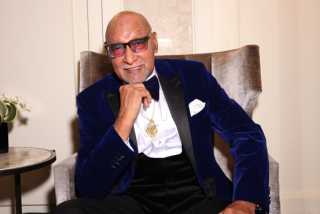Charles Earland; Jazz Organist
- Share via
Charles Earland, the hard-driving organist in the jazz-soul arena who over the last few years helped rekindle interest in the Hammond B-3 organ, has died.
Earland, 58, was found dead in a Kansas City hotel room Saturday morning just hours after finishing an engagement at the Blue Room, one of the city’s jazz clubs. The cause of death was a heart attack.
Born in Philadelphia, Earland, began primarily as an alto saxophonist, playing earnestly in a high school dance band that also included such jazz notables as saxophonist Lew Tabackin and guitarist Pat Martino. The band also included a trumpeter who would have a career in a different kind of music, Frankie Avalon.
Earland went on to play tenor and baritone saxophone but at 17 became interested in the Hammond B-3 while part of legendary organist Jimmy McGriff’s band.
He switched to organ in 1963 and got his first break on that instrument in the band of saxophonist Lou Donaldson, where he stayed until 1969.
Earland’s album “Black Talk” was a great commercial success and established him as a star on the organ. It also gained him a long-term contract with Prestige records.
He went on to tour Europe, playing soprano saxophone, synthesizer and electric piano as well as organ at many jazz festivals there.
Over the years his albums have ranged from burning funk, to transformations of pop tunes, to straight-ahead jazz. His music was included in the soundtracks of such films as “Fritz the Cat” and “The Dynamite Brothers.”
After hearing Earland at the Jazz Bakery in 1997, Times jazz writer Don Heckman termed his playing “driving, take-no-prisoners blitzkriegs of sound.”
“Typically he would play little repetitive riffs--often played against the basic meter of the rhythm--allowing them to build to an expanding, frenzied climax,” Heckman wrote. “Then suddenly [he would] break off the rhythm into a long, held note. The effect upon his audience was electrifying.”
In an interview with Down Beat magazine that same year, Earland spoke of the need for a new group of players to begin studying the Hammond B-3 to replace those legends of the instrument who were fading away.
“We’re not going to be here forever,” said Earland, who in the last few years was studying to become a minister.
He is survived by his wife, Sheila, and three children, Charles Earland III of Pasadena, Ahmad Earland of Lake Peekskill, N.Y., and Melissa Earland of Philadelphia.
More to Read
The biggest entertainment stories
Get our big stories about Hollywood, film, television, music, arts, culture and more right in your inbox as soon as they publish.
You may occasionally receive promotional content from the Los Angeles Times.










